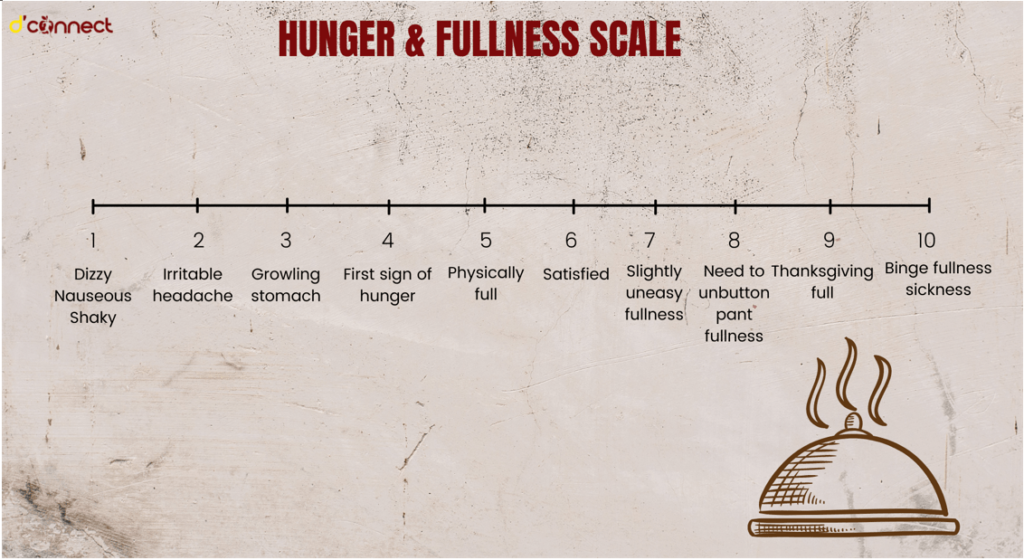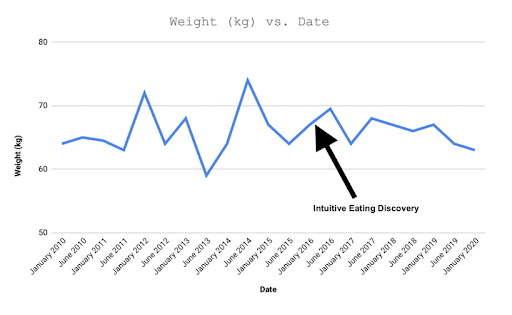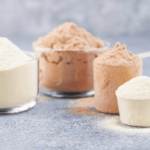
Tiana Hape-Cramond
(Associate Registered Nutritionist)
Intuitive Eating is a scientifically proven framework and an evidence-based approach to eating that emphasizes our internal cues such as listening to our own hunger levels, feeling good in our own body and rejecting the diet mentality.
There are 10 principles to Intuitive Eating, but before we start discussing in more detail, let’s see what intuitive eating is really all about.
What is Intuitive Eating
Intuitive Eating is a method aimed at achieving long-term behaviour change that promotes weight loss and weight maintenance. Intuitive eating differs from restrictive diets as these focus on ignoring the hunger cues that intuitive eating promotes.[1]
We need to get back in tune with our body and listen to the body’s internal hunger, satiety and appetite cues. Children know when they are full and they stop eating, and they also know when they don’t like something. Intuitive eating is tapping back into this kind of thinking and relying on the body’s intuition.[2]
What is the goal and purpose of Intuitive Eating

Intuitive eating is part of the body positivity movement where we accept the genetic makeup of the body and learn to embrace it without the negativity of the diet culture.[3]
All food should be viewed as emotionally equal and by removing the emotional value attached to food such (good or bad) food, it removes the guilt felt when enjoying food.
Although food has a purpose for supplying our body with the nutrients it needs, food is also an experience. Intuitive eating works on finding the joy in food again by reconnecting us with the body and learning to appreciate it.[3]
Building this relationship between food and the body means becoming more in-tune with the body and it’s needs, which can be used in the treatment and prevention of disorders such as anorexia.[2]
RELATED — Understanding Eating Disorders: History, Types and Statistics
Intuitive eating works on finding the joy in food and learning to appreciate it
How to start with Intuitive Eating
Knowing where to start with Intuitive Eating may be difficult. Focusing on the body is an important part of it which means understanding what the body wants and learning how to listen to it is fundamental for intuitive eating.
Letting go of the restrictions of dieting culture and learning to love ourselves, our bodies and food, are important steps in beginning the journey of intuitive eating. Here are some tips for sticking to intuitive eating and it’s principles.
Hunger – Fullness scale: Pay attention to the variations on hunger and fullness. Check in before, during and after eating to see whether you are still hungry or satisfied. Keeping a journal may be beneficial to keep track of hunger and fullness levels to begin to understand how the body is feeling.[3]

Eat what you want: Trusting the body is important for intuitive eating. Encouraging it to learn that it has access to all foods means that there is no food that is off limits. This may decrease cravings and overeating. Intuitive eating encourages eating foods that both satisfy the taste buds and health needs.[3]
Practice mindful eating: Mindful eating is being conscious of what you’re eating, why you’re eating and how you’re eating. Mindful eating means being present during the meal or snack and enjoying the food and experience.[3]
RELATED — A Guide to Mindful Eating
Stop policing food: When we are used to thinking about food being good or bad, it can be difficult to silence the inner voice that tells us not to eat. But if we listen to the body, it will indicate whether it is full and satisfied.[3]
10 Principles of Intuitive Eating
1. Reject diet mentality
Intuitive eating isn’t a (new) diet. It is known that diets are effective for losing weight but maintaining that weight loss is difficult.
Practicing intuitive eating means throwing out all the fad diets and celebrity diets to develop a strong and healthy relationship with food. You did not fail the diet – THE DIET FAILED YOU.
I would suggest unfollowing any influencers or pages that make people feel bad, and follow pages that encourage and inspire health and growth.[4]
2. Honour our Hunger
Food is a key part for survival. Keeping the body satisfied with the right amount of energy and carbohydrates will decrease the need to overeat.
Learning to listen to hunger cues is part of the intuitive eating journey and knowing how to use the Hunger-Fullness scale can assist with that. Being in tune with hunger cues begins the journey where we start trusting the body and food.[3]
3. Make Peace with Food
Give the body permission to eat. Telling the body what it can’t or shouldn’t eat, can have us craving “bad” foods which can lead to binge eating.[4]
Binge eating is not only bad for the body but it also comes with guilt which derails the healthy relationship that is being built with food. The key is to have “everything in moderation”.
RELATED — Binge Eating disorder: Is it a mental illness or an excuse to overeat?
Giving the body access to all foods, allows us to tame the cravings. Allowing unconditional permission to eat all the foods limits the opportunity for overeating and the guilt followed by over indulgence.
4. Challenge the Food Police
Food police was created by the unreasonable rules of the diet culture. Throwing out the labels of “good” and “bad” food creates less guilt that we feel about eating. Instead, it brings more enjoyment to the activity of eating.[4]
5. Discover the Satisfaction Factor
Often when eating, it’s easy to overlook the satisfaction and pleasure that eating can bring. Creating an environment where we can eat what we want without guilt can help us feel satisfied and content.
It allows us to enjoy the moment and be able to decide when we are full. Making eating an enjoyable experience helps build a better relationship with food.
6. Feel our Fullness
Listen to the body’s signals that indicate when it is full. When eating, pause and “check” the body’s current hunger level.[4]
The body knows itself best. When it is feeling full, it’s okay to stop eating. Eating can be an enjoyable experience and can be more satisfying when we are able to fully enjoy the food, but are also able to stop before becoming too full.
7. Use Kindness to cope with the Emotions
Negative emotions such as anxiety, loneliness and boredom are experienced by everyone and may trigger the need to eat.
Food won’t fix these problems and will only provide short-term comfort. It is important to acknowledge these feelings without feeling guilt and shame. Be kind to yourself.[4]
8. Respect your Body
Accept the genetic make-up! Just like height and shoe size, your genetics cannot be changed.
We are all different shapes and sizes and that’s how it’s supposed to be. Learn to accept and feel better about the body just the way it is. Once we are more body positive, it is easier to reject the diet mentality.[4]
RELATED — Read more about Health at Every Size.
9. Physical Activity – Feel the Difference
Shift your focus from working out to being active. Any physical activity is good activity! It could be as easy as taking the stairs or choosing a car park further away from the building.
RELATED — Hoffmann’s Hacks: Make exercise a part of your daily routine
Physical activity is known to reduce the risk of disease such as heart disease, type 2 diabetes and obesity.[5]
RELATED — Diabetes: Early Signs, Causes, Types and Treatment
10. Honour our Health – Gentle Nutrition
After a period of binge eating, our body will naturally crave healthy foods. Listening to the body can encourage it to realign itself with healthier choices.[4]
Make food choices that are beneficial to health. One snack or meal a day won’t make us unhealthy or cause a nutrient deficiency. We don’t have to eat perfectly all the time to be healthy.
Focus on foods that bring joy and make you feel good. Pleasure is an important factor in enjoying food and when we enjoy food, we can gain more satisfaction and long-lasting energy. Progress is the most important thing.[4]

Read more on 10 Principles of Intuitive Eating.
What's wrong with Intuitive Eating - The Criticism
Although intuitive eating has its advantages there are also criticisms to consider when thinking about whether intuitive eating is for you.
| Benefits of Intuitive Eating | Disadvantages of Intuitive Eating |
| Reduces the risks of overeating which will limit the guilt felt when eating.[4] | May not produce immediate weight loss. In some instances, we may gain weight while our body is becoming used to eating what we want.[7] |
| Greater enjoyment and pleasure when eating. | May be difficult to begin listening to hunger cues. |
| Natural maintenance of weight can lower BMI.[6] | Training our brain to stop categorising food as good or bad can be a long process. |
| Increases body acceptance.[6] | |
| Decreases restricted eating and disorders of eating.[6] | |
| Higher self-esteem and quality of life. | |
| Better sense of well-being. |
With every new idea, there are some criticisms but with practice and patience these can be challenged and overcome. Intuitive eating criticism concerns the way individuals want to use this concept.
This means that if people want to use intuitive eating to create healthier behaviours, then the criticisms can be overcome. Whereas if they are trying to use intuitive eating only for weight-loss, then the outcomes may not be the ones as desired.
Intuitive eating decreases restricted foods and promotes the quality of life
Weight loss and Intuitive Eating (before and after)
The important thing to remember about intuitive eating is that it is not a diet. The goal of intuitive eating is not to lose weight but instead to build and develop a better relationship between the body and food. Starting intuitive eating with the goal of losing weight undermines the principles of intuitive eating.
However, weight-loss is achievable but it will not be a quick result. In some instances, there may be some weight gain but in the long run intuitive eating has shown to decrease overeating and binge eating, which will reduce weight.

When comparing intuitive eating to a calorie restrictive diet, a calorie restrictive diet has a higher rate of weight loss. In saying that, diets can be hard to follow and over time we can become more relaxed with the diet and then begin to put weight back on.[7]
Intuitive eating is focused on changing the lifestyle and healthy behaviours. This means that people are more likely to stick to the lifestyle and have a greater chance of losing weight and being able to maintain the weight loss.
A study on intuitive eating was conducted over six weeks and found that all thirty-four participants did not lose weight. Instead, this group maintained weight and BMI throughout the intervention and the follow up period.[8]
Another study conducted on 200 female university students found that those who reported high levels of intuitive eating had a lower BMI than those who reported medium to low levels of intuitive eating. This shows that examining motivations for eating can be used to achieve and maintain goal weight.[9]
Read more about the study on Intuitive Eating and association with physical activity motivation and BMI.
Intuitive eating principles encourage living a well-rounded life with healthy food choices and exercise. Eating for physical purposes rather than emotional purposes also decreases the amount of food being consumed which encourages weight-loss.
If you are wanting a quick weight-loss then intuitive eating is not the best choice.
But if you want to develop a healthy and meaningful relationship with food, with the side benefit of weight maintenance, then intuitive eating is the way to go.
A few more things to know about Intuitive Eating
Intuitive Eating Counsellors
Yes, there is such a thing as certified intuitive eating counsellors. These counsellors are either health professionals such as health coaches or nutritionists or can be lay facilitators.[10]
Lay facilitators usually do not have any other health related degrees and only complete the intuitive eating course. To gain certification, these individuals must receive extensive training in Intuitive Eating taught by the creators of Intuitive Eating.
The role of Certified Intuitive Eating Counsellors is to guide people through developing a healthy relationship and uphold the intention and integrity of intuitive eating. There are currently five certified Intuitive Eating Counsellors in New Zealand which can be found in the directory.[10]
Intuitive Eating Workbook
Apart from the book on Intuitive Eating by Evelyn Tribole and Elyse Resch, they also created a workbook: The Intuitive Eating Workbook: Ten Principles for Nourishing a Healthy Relationship with Food.
RELATED — The Healthy Plate model – Essentials of Healthy Eating
The workbook is structured around the ten principles of intuitive eating and encourages healthy eating behaviours, positive body image and to stop stressing around food and eating. The workbook provides answers that help guide us through the journey of intuitive eating.
Intuitive Eating and Gender
A study was conducted and found that there was a significantly higher number of men using intuitive eating than women. This finding was not surprising given that westernised culture tends to put pressure on maintaining a certain body image and this pressure is felt more by women than men. Therefore, women may feel less encouraged to listen to their hunger cues and choose a more controlled diet.[11]
If you can’t wait and would like to know when the next article in the series will be coming out, you can join our healthy community and Subscribe to our Newsletter. It’s free.
Tiana is an Associate Registered Nutritionist who has a passion for public health and education. Working towards a Master’s in Nutrition Practice with a Bachelor’s in Human Nutrition, Tiana has a personal interest in healthy heart nutrition and promoting positive lifestyle behaviours.
Tiana is a part of the Content Team that brings you the latest news here at D’Connect.
References
(1) Mathieu J. What should you know about mindful and intuitive eating? Journal of the American Dietetic Association. 2009 Dec 1;109(12):1985.
(2) Bouchard I, Bouchard I. Intuitive Eating [Internet]. Bamboo Nutrition. 2021 [cited 31 July 2021]. Available from: https://www.bamboonutritionrd.com/blog/2019/3/29/5-steps-towards-becoming-an-intuitive-eater
(3) Alissa Rumsey R. How to Start Intuitive Eating | Intuitive Eating Guide [Internet]. Alissa Rumsey Nutrition | New York Registered Dietitian Nutritionist | Virtual Intuitive Eating Coaching. 2017 [cited 31 July 2021].
(4) 10 Principles of Intuitive Eating [Internet]. Intuitive Eating. 2019 [cited 31 July 2021]. Available from: https://www.intuitiveeating.org/10-principles-of-intuitive-eating/
(5) Warburton DE, Nicol CW, Bredin SS. Health benefits of physical activity: the evidence. Cmaj. 2006 Mar 14;174(6):801-9.
(6) Wilson RE. A brief non-dieting intervention increases intuitive eating and reduces dieting intention, body image dissatisfaction, and anti-fat attitudes: A randomized controlled trial (Doctoral dissertation, [Honolulu]:[University of Hawaii at Manoa], [August 2014]).
(7) Anglin JC. Assessing the effectiveness of intuitive eating for weight loss–pilot study. Nutrition and health. 2012 Apr;21(2):107-15.
(8) Bacon L, Stern JS, Van Loan MD, Keim NL. Size acceptance and intuitive eating improve health for obese, female chronic dieters. Journal of the American Dietetic Association. 2005 Jun 1;105(6):929-36.
(9) Gast J, Nielson AC, Hunt A, Leiker JJ. Intuitive eating: associations with physical activity motivation and BMI. American Journal of Health Promotion. 2015 Jan;29(3):e91-9.
(10) How to Become a Certified Intuitive Eating Counselor or Lay Facilitator [Internet]. Intuitive Eating. 2021 [cited 31 July 2021]. Available from: https://www.intuitiveeating.org/about-us/how-to-become-a-certified-intuitive-eating-counselor-or-lay-facilitator/
(11) Linardon J, Tylka TL, Fuller‐Tyszkiewicz M. Intuitive eating and its psychological correlates: A meta‐analysis. International Journal of Eating Disorders. 2021 Mar 30.






